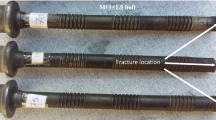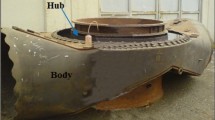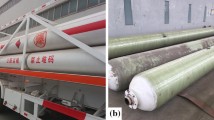Abstract
This article presents a failure analysis on a gasoline engine cylinder head made of aluminum alloy, which has been used in passenger cars. During an endurance test, a crack initiated from the interior wall of a hole in the center of the cylinder head and then propagated through the thickness of the cylinder head. The metallurgical examinations are conducted in the crack origin zone. The results show that there are many casting pores due to poor quality of casting in the failed cylinder head which has certainly played a crucial role in initiating the crack. Finite element analysis of the cylinder head is performed to identify the stress components. Modeling of a bolt for the hole shows that the plastic stresses are occurred. Moreover, the lower strength of the material due to high assembly stress caused the failure in the cylinder head.
Similar content being viewed by others
Avoid common mistakes on your manuscript.
Introduction
Cylinder heads are among the most important components in engines which are exposed to thermo-mechanical cyclic loads from the combustion chamber (thermal stresses) and bolts (mechanical stresses). Owing to these loads, the important parameter in the design of cylinder heads is known as thermo-mechanical fatigue strength. Also, because the correct performance of the cylinder head influences the performance parameters of engines such as power, torque, and fuel consumption and has a direct effect on environmental pollution, the design of this component according to fatigue loadings and lifetime has a high importance. Some actions, such as material selection, heat treatment process, and manufacturing methods including casting and machining, have more effects on the service life of the cylinder head.
During an endurance test (500 h off-road cycle), a cylinder head cast from AlSi8Cu3 failed with a crack initiating inside a hole in the center (between cylinder numbers 2 and 3) that was used for support during the casting process. After 434 engine working hours, the test was stopped because of the coolant fluid entering the combustion chamber. This event was repeated in another endurance test (400 h thermal change cycle) after 125 engine working hours. Owing to this repeated failure, this failure mode was chosen for investigation.
Two root causes are considered which include mechanical and material phenomena. Mechanical factors include the following:
-
Non-conformance of the geometric dimension and the tolerance of the cylinder head (such as the thickness around the hole) and the bolt according to the drawing.
-
A problem in fastening of the bolt.
-
The existence of excessive distortion in the cylinder head.
-
Excessive stresses due to fastening of the bolt and subsequent influence on fatigue.
-
Defects in cooling and lubricating systems of the engine.
The material factors include:
-
Non-conformance of the chemical composition with the specification.
-
Defects in microstructure near the cracked zone.
-
The existence of inclusions in the cylinder head.
-
Low strength and hardness.
As a result of these events, metallurgical investigations, fractography observation, finite element analysis, and some other measurements on failed cylinder head were conducted.
Observation Results
The cracked zone is shown in Fig. 1. Checking the cooling and lubricating systems of the engine shows no problem. The differences between coolant inlet and outlet temperatures were constant during the endurance test, and there was no leakage and coolant contamination in oil analysis. 20 h before engine stopping, the ECU sensed a knock, and the engine torque and power decreased because of retarding of the ignition time. After checking the engine performance condition by the defect analyzer device, it was found that there were no knocks. This was due to the crack initiation and decreasing of the cylinder head stiffness. It should be mentioned that until 300 h of the endurance test, fuel type was gasoline and then changed to compressed natural gas (CNG) type. As a result, the mean power of the engine increased from 100 to 110 kW, which can be a cause of higher thermal stresses.
Measurements
The bolt type that was tightened in the hole was DIN-906 which has a conical shape. In Fig. 2, the dimensions are shown. The results of measuring the bolt diameter and length as well as the thickness of the cylinder head (area 1 and area 2 in Fig. 3) showed a good conformance to the drawings. There was no plastic deformation noted during the visual inspection of the bolt threads. However, in the hole, threads were deformed. It should be mentioned that the material of the bolt is steel alloy in comparison with the hole made of aluminum alloy. The bolt pitch according to a straight line is 1.5 mm but for the hole thread, pitches are 1.46, 1.49, 1.52, 1.49, 1.50, and 1.51 mm, which indicate plastic deformation.
As is well known, deformation of a cylinder head has two modes including bending and torsion. Tightening torque of cylinder head bolts was 20 Nm continued with twisting of 120°. The removal torque of bolts and also the surface flatness of the cylinder head can approximately show the overall deformation (shown in Figs. 4 and 5). The cylinder head flatness was measured as 56 μm which is below the specification (100 μm max). The reported flatness is the difference between the deepest valleys and the highest peaks of the surface roughness.
Bolt lengths during the test were measured by ultrasonic device. Stress relaxations were calculated and are shown in Table 1. The results show that after the running-in test, the bolt lengths increase and then decrease because of stress relaxation. The changes in lengths were symmetric.
Material Investigation
The cracked zone was fully opened to investigate the fracture surface. Figure 6 shows the crack origins and the direction of propagation. Visual inspection revealed pores around the hole because of poor quality of the casting process which needs an optimization in melting, degassing, casting, and molding methods. The existence of these pores can produce a stress concentration for crack initiation and growth. Figure 7 shows casting pores.
Chemical Composition
The chemical composition of the failed cylinder head material was determined by a spectrographic chemical analysis method. The results are shown in Table 2. The cylinder head alloy conformed to the standard (of AlSi8Cu3) except for higher silicon content [1]. This element not only increases the strength and the hardness but also decreases the elongation to fracture.
Hardness Measuring [2, 3]
Brinell hardness tests with 250 Kg force and a steel indentor with 5-mm diameter were performed with 15 s interval on the specimen surface. The locations are shown in Figs. 8 and 9, and the results are listed in Table 3. It should be mentioned that the average hardness of the material was determined to be 121 HB 5/250 which is higher than the lower limit of the specification (90 HB) due to the higher amount of silicon.
Fractography [4, 5]
In order to investigate the microstructure and the heat treatment of the cylinder head material, a part of the cylinder head near the cracked zone was separated (as shown in Fig. 10). Pictures were taken after grinding, polishing, and etching the specimen surface in Keller’s reagent for 10 s. In Fig. 11, it is seen that the microstructure of the cylinder head material consisted of a solid solution of aluminum-silicon (rich phase is made of aluminum) and a uniform distribution of a eutectic silicon phase and also intermetallic phases. In general, the microstructure conforms to the standard [6, 7], but the pores, which are near the surface, can be a place of the stress concentration and can be a site of crack initiation during the cyclic thermo-mechanical loadings.
According to the standard [6], the allowable limit for porosity is 5% in a reference surface (which is 3 mm by 4 mm). Also 500 μm is the cutoff between micro- and macroporosity. A macro pore is a pore which can be seen visually without any microscope. Porosity was measured as 3% for the surface in Fig. 10 which is below the standard limit [6], but the diameter of the pores was more than 500 μm. As seen in the figure, the porosity distribution is high near the surface, and this can cause lower fatigue life.
SEM Investigation
To investigate the cracked surface more accurately, a scanning electron microscope (SEM) investigation was conducted, and the results are shown in Fig. 12 with different magnifications. According to Fig. 12, casting defects and pores were observed near the threads. It should be mentioned that the diameter of the pores was about 450 μm.
Finite Element Modeling
Finite element analysis of the cylinder head with and without modeling of the bolt for the hole at is performed at rated power conditions of the engine, including combustion pressure, temperature distribution, and assembly loadings.
The analysis included
-
(A)
Thermal analysis for finding the temperature distribution.
-
(B)
The structural analysis included
-
(a)
assembly loads (bolt forces, press-fits, conical bolt forces, and shrink-fits);
-
(b)
thermal load;
-
(c)
thermal load and gas pressure in cylinder number 2; and
-
(d)
thermal load and gas pressure in cylinder number 1.
-
(a)
To model the cylinder head and the engine block, nonlinear gasket elements and sliding contact definitions were used (Fig. 13). The full model size was reduced to 1/2 that of the model, and linear material models (Fig. 14) were utilized to simplify the calculation procedure. To model the bolt force, an external displacement of 0.235 mm on the 1/3 top of the bolt length was applied to the hole as shown in Fig. 15. The resulting Von-misses stress around the hole is shown in Fig. 15, which includes plastic deformations. The stress component in the x-direction (crack growth direction) and the maximum principal stress are shown in Fig. 16. As seen in the figure, by considering the bolt model, both stresses (x-component and maximum principal ones) increase.
Conclusion
Different tests were conducted to investigate the root causes of cracked cylinder head. The results show as follows:
-
The cracks initiated from the interior wall of the hole on the cylinder head and propagated through the thickness.
-
The chemical composition of the failed cylinder head basically corresponded to the specified range except for higher silicon content.
-
Higher silicon content causes higher hardness, higher strength and lower elongation of the material.
-
Casting pores were seen on the fracture surface, where their volume fraction was in the range of the standard [6], but the diameters were more than the allowable amount, to some extent. Also, deformation on the threads was observed.
However, these defects could not lead to a premature fracture of the cylinder head; the main reason for cracking was the high stress and the plastic strain due to the bolt assembly in the hole, which can be a cause of crack initiation. Subsequently, the pores near the surface of the threads as well as the cyclic thermo-mechanical loadings on the cylinder head could be a cause of the crack growth. To prevent this failure mode in the cylinder head, the hole could be eliminated, the type of the bolt could be changed, or the fastening torque could be adjusted.
References
Aluminium and Aluminium Alloys - Castings - Chemical Composition and Mechanical Properties, Standard No. DIN-EN-1706 (1998)
AlSi9Cu3 Aluminum Alloy Permanent Mold Casting Alloy Material Specification, Standard No. IK-150-11-1-0014 (2007)
Test Method for Brinell Hardness Test of Metallic Materials, Standard No. ASTM E10-06 (2006)
Properties and Selection: Nonferrous Alloys and Special-Purpose Materials, vol. 2. ASM Metals Handbook (1990)
Failure Analysis and Prevention, vol. 11. ASM Metals Handbook (1990)
Porosity Classification and Requirements for Casting Parts, Standard No. IK-150-11-1-0010 (2006)
Volume Defects of Castings made from Non-ferrous Metal, Standard No. IK-150-11-1-0011 (2006)
Acknowledgments
The authors thank the IPCo., including the laboratory, the CAE, and the design departments for the financial supports in experiments, especially Mr. Sharghi, Mr. Hosseini, Mr. Abaszadeh, Mr. Salimi, and Mr. Asadi.
Author information
Authors and Affiliations
Corresponding author
Rights and permissions
About this article
Cite this article
Azadi, M., Mafi, A., Roozban, M. et al. Failure Analysis of a Cracked Gasoline Engine Cylinder Head. J Fail. Anal. and Preven. 12, 286–294 (2012). https://doi.org/10.1007/s11668-012-9560-6
Received:
Revised:
Published:
Issue Date:
DOI: https://doi.org/10.1007/s11668-012-9560-6




















